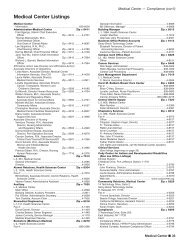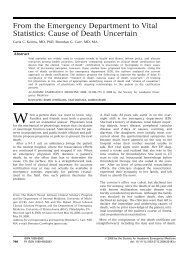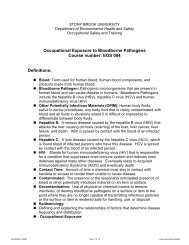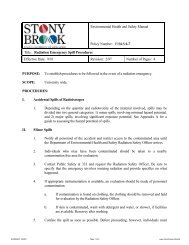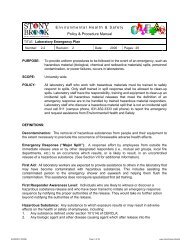Decision Making Patient-Centered Care and Preference-Sensitive
Decision Making Patient-Centered Care and Preference-Sensitive
Decision Making Patient-Centered Care and Preference-Sensitive
You also want an ePaper? Increase the reach of your titles
YUMPU automatically turns print PDFs into web optimized ePapers that Google loves.
Online article <strong>and</strong> related content<br />
current as of November 3, 2009.<br />
<strong>Patient</strong>-<strong>Centered</strong> <strong>Care</strong> <strong>and</strong> <strong>Preference</strong>-<strong>Sensitive</strong><br />
<strong>Decision</strong> <strong>Making</strong><br />
Carla C. Keirns; Susan Dorr Goold<br />
JAMA. 2009;302(16):1805-1806 (doi:10.1001/jama.2009.1550)<br />
http://jama.ama-assn.org/cgi/content/full/302/16/1805<br />
Correction<br />
Citations<br />
Topic collections<br />
Contact me if this article is corrected.<br />
Contact me when this article is cited.<br />
<strong>Patient</strong>-Physician Relationship/ <strong>Care</strong>; <strong>Patient</strong>-Physician Relationship, Other;<br />
Quality of <strong>Care</strong>; Evidence-Based Medicine; Quality of <strong>Care</strong>, Other<br />
Contact me when new articles are published in these topic areas.<br />
Subscribe<br />
http://jama.com/subscribe<br />
Email Alerts<br />
http://jamaarchives.com/alerts<br />
Permissions<br />
permissions@ama-assn.org<br />
http://pubs.ama-assn.org/misc/permissions.dtl<br />
Reprints/E-prints<br />
reprints@ama-assn.org<br />
Downloaded from www.jama.com by Carla Keirns on November 3, 2009
COMMENTARY<br />
<strong>Patient</strong>-<strong>Centered</strong> <strong>Care</strong> <strong>and</strong><br />
<strong>Preference</strong>-<strong>Sensitive</strong> <strong>Decision</strong> <strong>Making</strong><br />
Carla C. Keirns, MD, MA, MS, PhD<br />
Susan Dorr Goold, MD, MHSA, MA<br />
OVER THE PAST 20 YEARS OR SO, THERE HAS BEEN A<br />
rise of 2 parallel movements, one toward the explicit<br />
use of clinical trial data to guide clinical practice<br />
(evidence-based medicine) <strong>and</strong> the other toward<br />
patient empowerment through explicit informed consent,<br />
shared decision making, <strong>and</strong> patient-centered care. Both components<br />
have been integrated into models of quality clinical<br />
care, but sometimes there are conflicts between evidence- <strong>and</strong><br />
guideline-driven care <strong>and</strong> patient-centered care.<br />
In most situations, patients value prevention of disease<br />
<strong>and</strong> disability <strong>and</strong> increased length of life, so patientcentered<br />
care <strong>and</strong> application of evidence-based medicine<br />
present no conflict. Despite general preferences for health<br />
over disease, however, individuals make trade-offs every day<br />
by working in dangerous or stressful jobs, driving too fast,<br />
eating too much, smoking, <strong>and</strong> taking dozens of other risks,<br />
large <strong>and</strong> small. These everyday compromises are also seen<br />
in clinical practice. <strong>Patient</strong>s may choose a less expensive<br />
medication even if that medication is not quite as effective.<br />
They may choose a more limited operation for cancer, explicitly<br />
trading off survival for quality of life. They may decline<br />
chemotherapy because they feel the adverse effects are<br />
not worth the small chance of success.<br />
When the choices are about technologies at the end of life,<br />
it has now been accepted in the United States <strong>and</strong> much of<br />
the world that patients who value quality of life over length<br />
of life are making a reasonable <strong>and</strong> justifiable decision. Shared<br />
decision making is also a common feature of more straightforward<br />
medical decisions, but because the immediate stakes<br />
are lower, the quality of these negotiations has been subject<br />
to less scrutiny. Even the everyday decisions about which blood<br />
pressure medicine to choose, how to manage diabetes, when<br />
to start dialysis, <strong>and</strong> what is needed to prevent or treat heart<br />
disease present these compromises between increased survival<br />
<strong>and</strong> reduced complication <strong>and</strong> other goals patients may<br />
have including cost, time, <strong>and</strong> control over their lives. 1<br />
Guideline-Directed <strong>Care</strong><br />
<strong>and</strong> Pay for Performance<br />
Pay-for-performance programs have highlighted longst<strong>and</strong>ing<br />
but largely unarticulated differences in h<strong>and</strong>ling<br />
conflicts between patients’ goals <strong>and</strong> preferences <strong>and</strong> clinical<br />
recommendations. Pay for performance also risks increasing<br />
the stakes in conflict between clinicians <strong>and</strong> patients,<br />
pushing clinicians toward a “take it or leave it” stance<br />
with “nonadherent” patients or dismissing them from their<br />
practices lest they decrease quality measures. The challenges<br />
in implementation of pay for performance, including<br />
failure to adequately account for patients’ baseline health<br />
status, 2 have been debated elsewhere 3,4 ; here the focus is on<br />
potential conflicts between performance measures <strong>and</strong> patient-centered<br />
care. Pay-for-performance st<strong>and</strong>ards rarely account<br />
for patients’ preferences regarding management intensity,<br />
adverse effects, <strong>and</strong> overall self-management burden. 5<br />
When <strong>Patient</strong>-<strong>Centered</strong> <strong>Care</strong> Conflicts<br />
With Quality St<strong>and</strong>ards<br />
<strong>Patient</strong>s’ preferences increasingly factor into decisions between<br />
surgery, chemotherapy, <strong>and</strong> radiation for various cancers.<br />
On the other h<strong>and</strong>, there has been a countervailing push<br />
toward stricter st<strong>and</strong>ards in the management of chronic diseases,<br />
because of increasing evidence of benefit. But such<br />
recommendations also need to account for heterogeneity of<br />
benefit: treating a 30-year-old diabetic patient to reach a goal<br />
hemoglobin A 1C level of less than 7% probably provides substantial<br />
benefit realized over decades of reduced complications<br />
<strong>and</strong> offers a reasonable risk profile, whereas aggressively<br />
treating an 80-year-old diabetic patient provides<br />
relatively little benefit <strong>and</strong> substantial risk of harm due to<br />
adverse effects <strong>and</strong> complications of therapy. 6<br />
Physician recommendations should always include the<br />
rationale, expected outcome, <strong>and</strong> alternatives. If a patient<br />
refuses care that has a high likelihood of changing his or<br />
her personal risk for mortality or serious complications—<br />
not just average risk across a population—this decision needs<br />
to be explored. What are the patient’s goals in life <strong>and</strong> health?<br />
Author Affiliations: Robert Wood Johnson Clinical Scholars Program, University<br />
of Michigan School of Medicine, Ann Arbor (Drs Keirns <strong>and</strong> Goold); Department<br />
of Internal Medicine, University of Michigan Medical Center, Ann Arbor (Drs Keirns<br />
<strong>and</strong> Goold); Bioethics Program, University of Michigan, Ann Arbor (Drs Keirns <strong>and</strong><br />
Goold); VA Health Services Research <strong>and</strong> Development Center of Excellence <strong>and</strong><br />
Department of Ambulatory <strong>Care</strong>, Ann Arbor VA Health System (Dr Keirns); <strong>and</strong><br />
Center for Medical Humanities, Compassionate <strong>Care</strong>, <strong>and</strong> Bioethics, Departments<br />
of Preventive Medicine <strong>and</strong> Department of Medicine, Stony Brook University,<br />
Stony Brook, New York (Dr Keirns).<br />
Corresponding Author: Carla C. Keirns, MD, MA, MS, PhD, Center for Medical<br />
Humanities, Compassionate <strong>Care</strong>, <strong>and</strong> Bioethics, Department of Preventive Medicine,<br />
Stony Brook University, HSC Level 3, Room 080, Stony Brook, NY 11794-<br />
8335 (carla.keirns@stonybrook.edu).<br />
©2009 American Medical Association. All rights reserved. (Reprinted with Corrections) JAMA, October 28, 2009—Vol 302, No. 16 1805<br />
Downloaded from www.jama.com by Carla Keirns on November 3, 2009
COMMENTARY<br />
Does the patient underst<strong>and</strong> the trade-off he or she is making?<br />
Is the decision due to cost, adverse effects, experience<br />
of a friend or family member? Is the patient depressed <strong>and</strong><br />
therefore not making decisions consistent with his or her<br />
long-term values <strong>and</strong> interests? Sometimes it may be appropriate<br />
to try persuading a reluctant patient or to address<br />
obstacles such as cost or adverse effects; at other times<br />
the patient’s reason may be compelling or unlikely to change.<br />
Accepting the <strong>Patient</strong>’s <strong>Decision</strong><br />
<strong>Patient</strong>s may have many priorities in addition to improving<br />
their health, such as making a living, caring for family,<br />
<strong>and</strong> engaging in leisure activities, <strong>and</strong> these life activities<br />
frequently involve trade-offs between health, comfort, relationships,<br />
<strong>and</strong> financial well-being. <strong>Patient</strong>-centered care<br />
requires that physicians try to underst<strong>and</strong> patient goals <strong>and</strong><br />
priorities, incorporate clinical <strong>and</strong> patient priorities, <strong>and</strong> address<br />
obstacles to care. Clinical care needs to promote patients’<br />
health priorities in light of the rest of their lives. Further,<br />
professional ethics unequivocally supports competent<br />
adult patients’ right to accept or decline any medical intervention,<br />
even at risk of death.<br />
When patients decline recommended treatments,<br />
research suggests patients <strong>and</strong> physicians often differ in<br />
their beliefs about disease, 7 goals of treatment, 8 <strong>and</strong><br />
desire for control. 9 Cost, forgetfulness, adverse effects, or<br />
comorbidities, as well as unstated disagreement, influence<br />
patient behavior. <strong>Patient</strong>s also bring their own<br />
agenda to a visit; treatment of pain, mental illness, or<br />
improved function can compete with the agenda of<br />
guideline-directed care of chronic diseases. It is incumbent<br />
on clinicians to be sure that patients underst<strong>and</strong> the<br />
short- <strong>and</strong> long-term consequences of their choices <strong>and</strong><br />
then to negotiate the best compromise to optimize outcomes<br />
consistent with the patient’s goals.<br />
Physician Payment Formulas Can Hinder<br />
Individualized <strong>Care</strong><br />
Both fee-for-service payment formulas <strong>and</strong> pay-forperformance<br />
programs may penalize clinicians for providing<br />
patient-centered care. If patients decline additional medication<br />
because of adverse effects or treatment burden <strong>and</strong><br />
their blood pressure is near but not at optimal targets, physicians<br />
in pay for performance may be penalized for failing<br />
to meet treatment targets. Dialysis centers are currently paid<br />
for each treatment session, so a center that accommodates<br />
a different schedule for one patient would only be paid for<br />
the number of sessions completed under current fee-forservice<br />
arrangements. In the future under pay for performance,<br />
nephrologists could face penalties for failing to meet<br />
quality st<strong>and</strong>ards for dialysis “dose” even if fewer doses could<br />
be justified on the basis of residual renal function or patient<br />
treatment goals.<br />
Since clinicians may have relatively small sample sizes on<br />
which performance is measured, 10 even 1 patient whose<br />
shared decision making results in “poor care” can have a<br />
marked influence on a physician’s or facility’s overall quality<br />
ratings. Physicians might then refuse to accept some<br />
patients or refuse to tailor care to patients’ needs <strong>and</strong> preferences.<br />
Recommendations<br />
Every patient should be offered sound advice based on<br />
the best available evidence. Physician recommendations<br />
should always include the expected outcome; alternatives,<br />
including doing nothing; <strong>and</strong> expected outcomes<br />
for those alternatives. <strong>Patient</strong>-centered care can improve<br />
trust, communication, <strong>and</strong> adherence to therapy, thereby<br />
improving quality benchmarks <strong>and</strong> clinical outcomes.<br />
But competent adult patients also have the right to<br />
decline to follow that advice <strong>and</strong> to negotiate with physicians<br />
a plan of care that better meets their own goals. To<br />
make care patient-centered <strong>and</strong> consent truly informed,<br />
<strong>and</strong> to build longitudinal relationships of trust between<br />
patients <strong>and</strong> the physicians who care for them, patients’<br />
goals <strong>and</strong> preferences need to be incorporated into treatment<br />
plans, <strong>and</strong> a patient’s firm, unambiguous, reasoned<br />
“no thanks” also needs to be honored.<br />
Financial Disclosures: None reported.<br />
Funding/Support: This work received support from the Robert Wood Johnson Clinical<br />
Scholars Program at the University of Michigan <strong>and</strong> the Fondation Brocher.<br />
Role of the Sponsor: The Robert Wood Johnson Foundation <strong>and</strong> the Fondation<br />
Brocher had no role in the preparation, review, or approval of the manuscript.<br />
Disclaimer: The content of this article is solely the responsibility of the authors<br />
<strong>and</strong> does not necessarily represent the official views of the Robert Wood Johnson<br />
Foundation.<br />
Additional Contributions: Theodore J. Iwashyna, MD, PhD (University of Michigan);<br />
Rodney Hayward, MD (University of Michigan <strong>and</strong> Ann Arbor VA Medical<br />
Center); <strong>and</strong> Raymond DeVries, PhD (University of Michigan), provided helpful<br />
advice, for which they were not compensated.<br />
REFERENCES<br />
1. Heisler M, Tierney E, Ackermann RT, et al. Physicians participatory decisionmaking<br />
<strong>and</strong> quality of diabetes care processes <strong>and</strong> outcomes: results from the triad<br />
study. Chronic Illn. 2009;5(3):165-176.<br />
2. Pine M, Jordan HS, Elixhauser A, et al. Enhancement of claims data to improve<br />
risk adjustment of hospital mortality. JAMA. 2007;297(1):71-76.<br />
3. Wharam JF, Paasche-Orlow MK, Farber NJ, et al. High quality care <strong>and</strong> ethical<br />
pay-for-performance: a Society of General Internal Medicine policy analysis. J Gen<br />
Intern Med. 2009;24(7):854-859.<br />
4. Wynia MK. The risks of rewards in health care: how pay-for-performance could<br />
threaten, or bolster, medical professionalism. J Gen Intern Med. 2009;24(7):<br />
884-887.<br />
5. Parchman ML, Pugh JA, Romero RL, Bowers KW. Competing dem<strong>and</strong>s or clinical<br />
inertia: the case of elevated glycosylated hemoglobin. Ann Fam Med. 2007;<br />
5(3):196-201.<br />
6. Boyd CM, Darer J, Boult C, Fried LP, Boult L, Wu AW. Clinical practice guidelines<br />
<strong>and</strong> quality of care for older patients with multiple comorbid diseases: implications<br />
for pay for performance. JAMA. 2005;294(6):716-724.<br />
7. Michaels C, McEwen MM, McArthur DB. Saying “no” to professional recommendations:<br />
client values, beliefs, <strong>and</strong> evidence-based practice. J Am Acad Nurse<br />
Pract. 2008;20(12):585-589.<br />
8. Goff SL, Mazor KM, Meterko V, Dodd K, Sabin J. <strong>Patient</strong>s’ beliefs <strong>and</strong> preferences<br />
regarding doctors’ medication recommendations. J Gen Intern Med. 2008;<br />
23(3):236-241.<br />
9. Schneider JW, Conrad P. Having Epilepsy: the Experience <strong>and</strong> Control of Illness.<br />
Philadelphia, PA: Temple University Press; 1983.<br />
10. Krein SL, Hofer TP, Kerr EA, Hayward RA. Whom should we profile? examining<br />
diabetes care practice variation among primary care providers, provider groups,<br />
<strong>and</strong> health care facilities. Health Serv Res. 2002;37(5):1159-1180.<br />
1806 JAMA, October 28, 2009—Vol 302, No. 16 (Reprinted with Corrections) ©2009 American Medical Association. All rights reserved.<br />
Downloaded from www.jama.com by Carla Keirns on November 3, 2009






